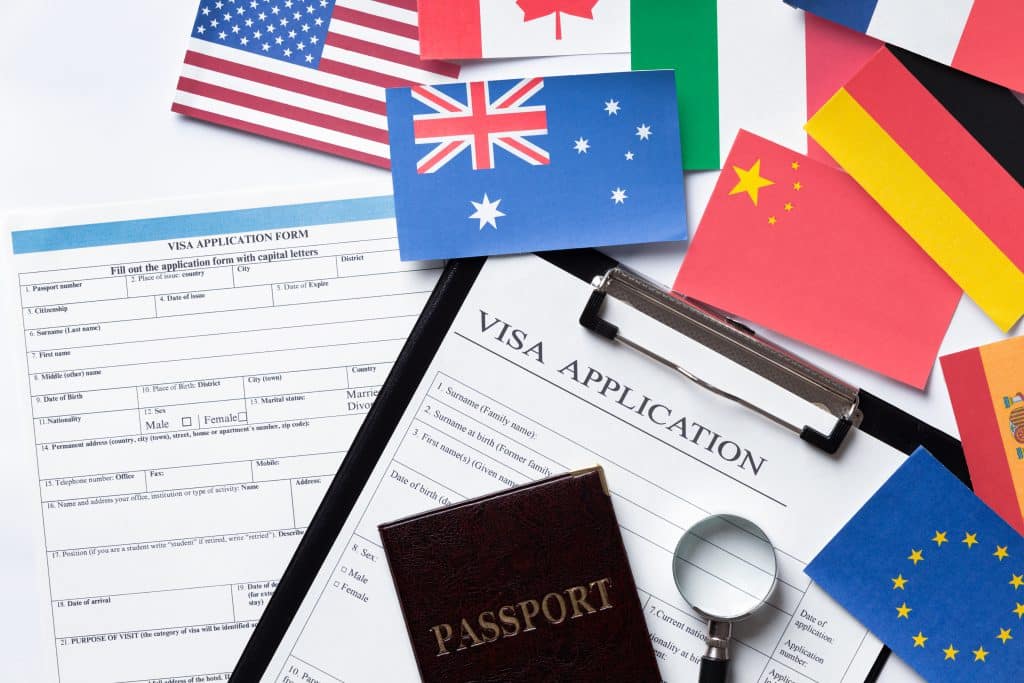Discover legitimate pathways for no-cost work visas to the EU and USA. This definitive guide reveals employer-sponsored programs, freelance visas, and government schemes to launch your international career without paying fees.
Introduction: Debunking the Myth of the $10,000 Visa
The dream of working in a vibrant European capital or a leading American tech hub is a powerful motivator for global talent. Yet, for many, this dream is seemingly crushed by a single, daunting figure: the cost. A quick internet search can leave you believing that securing a work visa requires thousands of dollars in government fees, legal expenses, and bureaucratic overhead.
What if that common belief is a myth?
What if there are completely legal, established pathways to obtain authorization to work in countries like Germany, the Netherlands, Portugal, and even the United States without you, the employee, paying the central government visa application fees?
This guide is dedicated to the concept of the “No-Cost Work Visa.” It’s crucial to define this term from the outset. A “no-cost” visa does not mean every single ancillary expense disappears. You may still need to budget for:
- Essential Documentation: Passport renewal, document translation, and notarization.
- Mandatory Health Insurance: A non-negotiable requirement for nearly all visa types.
- Biometrics Appointment: A minor fee for photo and fingerprint collection.
- Relocation: Flights, shipping, and initial accommodation.
However, the core government filing fee—often the most significant and non-negotiable cost—can be $0. This is achieved through two primary strategies:
- Targeting visa categories that, by their very design, have no government filing fee for the applicant.
- Securing an employer who, bound by law or as part of a competitive hiring package, agrees to sponsor you and cover all visa-related costs.
This article will serve as your master blueprint. We will dissect the immigration systems of the EU and USA, highlighting the specific programs, visas, and negotiation tactics that can turn your dream of a cost-free international career into a tangible plan for 2025.
Section 1: The Foundation – Who Really Pays for a Work Visa?
Understanding the economics of visa sponsorship is the first step toward a no-cost outcome. The financial responsibility is typically split between three parties:
- The Government: Charges fees to process applications, conduct security checks, and administer the immigration system. These fees are fixed and published.
- The Employer: Often bears the heaviest burden. In many cases, U.S. law explicitly prohibits employers from passing certain visa fees onto the employee. For European countries, while the laws may be less strict, competitive employers frequently cover these costs to attract top global talent.
- The Employee: Traditionally covers personal costs like passports, photos, travel, and sometimes legal consultation.
The “no-cost” strategy focuses on minimizing your out-of-pocket expenses by leveraging employer sponsorship and targeting fee-waived visa streams. Your goal is to shift from the red section to the green.
Section 2: The European Union – A Patchwork of No-Cost Opportunities
The EU doesn’t have a single immigration policy; each member state has its own rules. This creates a landscape of opportunity where savvy applicants can find pathways with minimal fees.
Strategy 1: The Employer-Sponsored “Golden Ticket”
This is the most reliable method for a truly no-cost visa. Your employer handles the application and pays all associated government and legal fees.
Top Country Picks:
- The Netherlands: The Highly Skilled Migrant Permit
- How it Works: The Dutch system is incredibly employer-centric. If a company is recognized as a sponsor by the Immigration and Naturalisation Service (IND), the process is streamlined. Crucially, the government application fee for the employee is €0. The employer pays a fee of approximately €350.
- How to Get It: Your entire job search must focus on the IND’s published list of Recognized Sponsors. These companies are pre-vetted and experienced with immigration.
- Action Plan: Use LinkedIn to search for “Recognized Sponsor” companies in your field in the Netherlands. In your job applications and interviews, be transparent about your need for sponsorship. For in-demand roles (tech, engineering, finance), this is a standard expectation.
- Germany: The EU Blue Card
- How it Works: For highly-skilled professionals with a university degree and a job offer meeting a minimum salary threshold (expected to be ~€45,000-€58,000 in 2025). The government fee is a reasonable €140, but the potential for a no-cost outcome is high.
- How to Make it No-Cost: During salary and offer negotiations, explicitly request that the employer cover the EU Blue Card application fee and any associated legal costs as part of your relocation package. German companies facing talent shortages are often amenable to this.
- Action Plan: Target Germany’s industrial giants (Siemens, Bosch), its vibrant startup scene (Berlin), and its automotive sector. Highlight your in-demand skills.
Strategy 2: The Freelance & Self-Employment Visa
For entrepreneurs, consultants, and digital nomads, several EU countries offer visas with low startup costs.
- Czech Republic: The Živnostenský List (Trade License)
- How it Works: You apply for a long-term visa for the purpose of business. You obtain a trade license for your profession (a simple administrative process with a tiny fee) and prove sufficient funds. The visa fee itself is around €80.
- The “No-Cost” Angle: While there’s a small fee, the total government cost is under €200, making it one of the most accessible options. The challenge is often bureaucratic navigation, which may require a one-time legal fee (~€1,000).
- Action Plan: Research if your profession is on the “free trade” list. Join expat forums to find affordable legal help for the application.
- Portugal: The D7 Passive Income & Digital Nomad Visa
- How it Works: The D7 is for those with sustainable passive income (rentals, dividends, pensions). The Digital Nomad visa is for remote workers with foreign clients/employers. Both require proof of income (~€700-€3,300/month).
- The “No-Cost” Angle: The application fees are modest (approx. €90 for the visa, €83 for the residence permit). The visa’s affordability and Portugal’s high quality of life are the key benefits.
- Action Plan: Secure a stable remote income stream. Gather 6-12 months of bank statements and client contracts.
Strategy 3: The Job-Seeker Visa
This visa allows you to move to a country first and then find a job, often with the employer then handling the conversion to a work permit at their cost.
- Germany: The Job Seeker Visa
- How it Works: A 6-month visa that allows you to live in Germany while searching for employment. The fee is approximately €75.
- The “No-Cost” Angle: The minimal fee is an investment. Once you secure a job offer, your German employer will typically sponsor your work permit and cover those associated costs, effectively making the long-term permission “no-cost” from that point forward.
- Action Plan: Ensure your qualifications are recognized in Germany. Secure proof of financial means for the initial 6 months. Begin networking with German companies before you even arrive.
Section 3: The United States – Navigating a High-Cost System for a No-Cost Outcome
The U.S. system is complex and expensive for employers, but laws exist to protect employees from bearing the cost burden. Your negotiation skills are critical here.
The Premier Path: The L-1 Intracompany Transferee Visa
This is arguably the most straightforward no-cost path to the USA.
- How it Works: If you have worked for a multinational company outside the U.S. for at least one continuous year within the last three, you can be transferred to a related U.S. office.
- The No-Cost Reality: This is a corporate transfer. The company will cover all costs as a matter of standard practice. This includes all government filing fees ($460), legal fees (>$5,000), and very often, relocation packages covering flights, housing, and moving expenses.
- Action Plan: Get hired by a multinational company with a significant U.S. presence. Excel in your role and make your career ambitions known to your manager. Internal mobility is often easier than external hiring.
The Lottery-Based Path: The H-1B (Specialty Occupations)
- How it Works: For professionals in specialty occupations requiring a bachelor’s degree. It’s an annual lottery with low odds (~30%).
- The Law: U.S. law mandates that the employer pays the mandatory filing fees. These can total over $3,000 for standard processing. They cannot legally make you repay these fees.
- The Negotiation: While the law covers the basics, you can negotiate for them to also cover the optional “Premium Processing” fee ($2,500 for a 15-day decision) and any legal costs they might attribute to your case.
- Action Plan: Target large tech and finance firms (Google, Amazon, JPMorgan, Apple) that have dedicated immigration departments and routinely sponsor H-1Bs. They expect to pay these costs.
The Elite Path: The O-1 Visa (Extraordinary Ability)
- How it Works: For individuals demonstrating sustained national or international acclaim in sciences, arts, education, business, or athletics.
- The No-Cost Strategy: The government fee is only $460. However, the legal effort to build a winning petition is immense, often costing $5,000-$10,000+ in legal fees. Your strategy is to get a U.S. employer or agent to petition for you and agree to cover all associated costs because your talent is worth the investment.
- Action Plan: Start building a portfolio of evidence now: awards, media mentions, published work, letters of recommendation from recognized experts, and evidence of a high salary.
Section 4: Beyond the Visa – Mastering the No-Cost Relocation
Securing a no-cost visa is a huge victory, but a full relocation has other expenses. Here’s how to manage them:
- Negotiate a Relocation Package: As part of your job offer, negotiate a lump-sum payment or direct reimbursement for:
- Flight costs for you and your family.
- Shipping of personal belongings.
- Temporary housing for the first 1-2 months.
- Agency fees to help you find a permanent apartment (common in Europe).
- Time Your Move: If you receive a signing bonus, use it to offset initial setup costs.
- Utilize Government Resources: Some countries or even cities offer integration support, like free language classes or networking events, which can reduce your personal expenses.
Your 6-Month No-Cost Visa Action Plan
Month 1-2: Target & Research
- Identify 2-3 target countries based on your skills and lifestyle.
- Bookmark the official government immigration websites (.gov/.eu domains).
- For employer-sponsored paths, find lists of recognized sponsors (e.g., Netherlands IND list).
Month 3-4: Build Your Profile
- Optimize your LinkedIn/CV with keywords for your target country and industry.
- For freelance visas, solidify your client base and income documentation.
- For O-1, begin collecting evidence of your “extraordinary ability.”
Month 5-6: Execute & Negotiate
- Begin applying for jobs, stating your sponsorship needs clearly.
- Start gathering core documents: passport, degree certificates, bank statements.
- Practice your negotiation script: “As part of my offer, I will require full visa sponsorship, including coverage of all government and legal fees. Does your company have a standard policy for this?”
Conclusion: Your Global Career on Your Terms
The path to a no-cost work visa is not a hidden secret; it is a strategic choice. It requires you to shift your mindset from being a passive applicant to becoming a valuable asset that employers and countries compete to attract.
By focusing on employer-sponsored pathways in the Netherlands and USA, leveraging low-fee freelance visas in Central Europe, or pursuing a strategic internal transfer with an L-1 visa, you can absolutely minimize or eliminate the out-of-pocket costs of your international move.
The information is all publicly available. The companies are actively hiring. The programs are in place. Your task is to take this blueprint, apply it with diligence and confidence, and take the first step toward the career and life you deserve.


